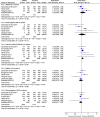Attention-deficit hyperactivity disorder in adults: A systematic review and meta-analysis of genetic, pharmacogenetic and biochemical studies
- PMID: 27217152
- PMCID: PMC5414093
- DOI: 10.1038/mp.2016.74
Attention-deficit hyperactivity disorder in adults: A systematic review and meta-analysis of genetic, pharmacogenetic and biochemical studies
Erratum in
-
Attention-deficit hyperactivity disorder in adults: a systematic review and meta-analysis of genetic, pharmacogenetic and biochemical studies.Mol Psychiatry. 2016 Nov;21(11):1643. doi: 10.1038/mp.2016.128. Epub 2016 Aug 9. Mol Psychiatry. 2016. PMID: 27502472 Free PMC article. No abstract available.
Abstract
The adult form of attention-deficit/hyperactivity disorder has a prevalence of up to 5% and is the most severe long-term outcome of this common disorder. Family studies in clinical samples as well as twin studies suggest a familial liability and consequently different genes were investigated in association studies. Pharmacotherapy with methylphenidate (MPH) seems to be the first-line treatment of choice in adults with attention-deficit hyperactive disorder (ADHD) and some studies were conducted on the genes influencing the response to this drug. Finally some peripheral biomarkers were identified in ADHD adult patients. We believe this work is the first systematic review and meta-analysis of candidate gene association studies, pharmacogenetic and biochemical (metabolomics) studies performed in adults with ADHD to identify potential genetic, predictive and peripheral markers linked specifically to ADHD in adults. After screening 5129 records, we selected 87 studies of which 61 were available for candidate gene association studies, 5 for pharmacogenetics and 21 for biochemical studies. Of these, 15 genetic, 2 pharmacogenetic and 6 biochemical studies were included in the meta-analyses. We obtained an association between adult ADHD and the gene BAIAP2 (brain-specific angiogenesis inhibitor 1-associated protein 2), even after Bonferroni correction, with any heterogeneity in effect size and no publication bias. If we did not apply the Bonferroni correction, a trend was found for the carriers allele 9R of dopamine transporter SLC6A3 40 bp variable tandem repeat polymorphism (VNTR) and for 6/6 homozygotes of SLC6A3 30 bp VNTR. Negative results were obtained for the 9-6 haplotype, the dopamine receptor DRD4 48 bp VNTR, and the enzyme COMT SNP rs4680. Concerning pharmacogenetic studies, no association was found for the SLC6A3 40 bp and response to MPH with only two studies selected. For the metabolomics studies, no differences between ADHD adults and controls were found for salivary cortisol, whereas lower serum docosahexaenoic acid (DHA) levels were found in ADHD adults. This last association was significant even after Bonferroni correction and in absence of heterogeneity. Other polyunsaturated fatty acids (PUFAs) such as AA (arachidonic acid), EPA (eicosapentaenoic acid) and DyLA (dihomogammalinolenic acid) levels were not different between patients and controls. No publication biases were observed for these markers. Genes linked to dopaminergic, serotoninergic and noradrenergic signaling, metabolism (DBH, TPH1, TPH2, DDC, MAOA, MAOB, BCHE and TH), neurodevelopment (BDNF and others), the SNARE system and other forty genes/proteins related to different pathways were not meta-analyzed due to insufficient data. In conclusion, we found that there were not enough genetic, pharmacogenetic and biochemical studies of ADHD in adults and that more investigations are needed. Moreover we confirmed a significant role of BAIAP2 and DHA in the etiology of ADHD exclusively in adults. Future research should be focused on the replication of these findings and to assess their specificity for ADHD.
Conflict of interest statement
In the past year, Dr Faraone received income, potential income, travel expenses and/or research support from Arbor, Pfizer, Ironshore, Shire, Akili Interactive Labs, CogCubed, Alcobra, VAYA Pharma, Neurovance, Impax, NeuroLifeSciences. With his institution, he has US patent US20130217707 A1 for the use of sodium-hydrogen exchange inhibitors in the treatment of ADHD. The remaining authors declare no conflict of interest.
Figures


References
-
- Wilens TE, Faraone SV, Biederman J. Attention-deficit/hyperactivity disorder in adults. JAMA 2004; 292: 619–623. - PubMed
-
- Faraone S, Biederman J, Mick E. The age dependent decline of attention-deficit/hyperactivity disorder: a meta-analysis of follow-up studies. Psychol Med 2006; 36: 159–165. - PubMed
-
- Polanczyk G, de Lima MS, Horta BL, Biederman J, Rohde LA. The worldwide prevalence of ADHD: a systematic review and metaregression analysis. Am J Psychiatry 2007; 164: 942–948. - PubMed
Publication types
MeSH terms
Substances
Grants and funding
LinkOut - more resources
Full Text Sources
Other Literature Sources
Medical
Research Materials
Miscellaneous

